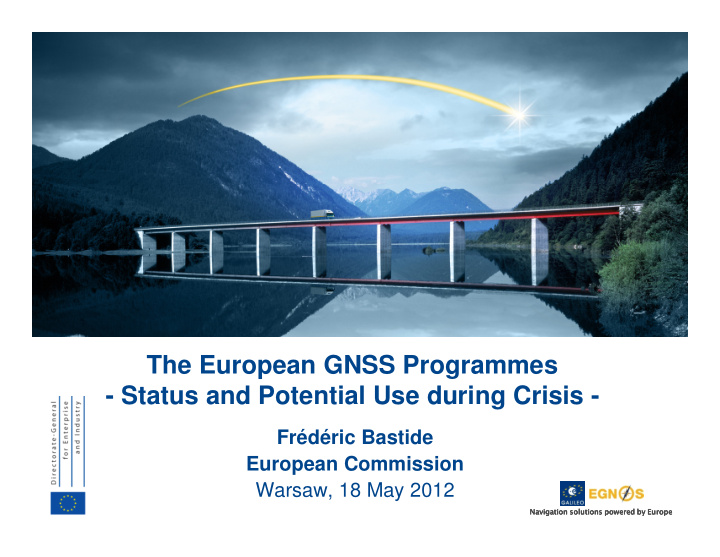



The European GNSS Programmes - Status and Potential Use during Crisis - Frédéric Bastide European Commission Warsaw, 18 May 2012 �������������������������������������� �������������������������������������� �������������������������������������� ��������������������������������������
EGNOS is Fully Operational �������������������������������������� �������������������������������������� �������������������������������������� �������������������������������������� � EGNOS open service is operational since October 2009 � EGNOS Safety of Life service was declared operational in March 2011 � Pau Pyrénées airport (France) became Europe’s first airport to use the EGNOS Safety of Life service to guide in aircraft for landing in May 2011 � Since December 2011, the EGNOS-based LPV procedures at Alderney airport (Channel Islands) are the first in Europe to be used for commercial flights � Over 100 EGNOS approach procedures for aircraft landings already published in Europe LPV: Localizer Performance with Vertical guidance The European GNSS Programmes 2
Galileo is Taking Off �������������������������������������� �������������������������������������� �������������������������������������� �������������������������������������� � The first 2 operational satellites were launched on 21 October 2011 (in addition to the two test satellites launched in 2005 and 2008) � Further two Galileo satellites will be launched on the 28 th of September 2012 � All industrial contracts necessary to ensure early Galileo services in 2014 have been signed � To accelerate Galileo’s deployment and to further contain costs, the following contracts were signed on 2 February 2012: - Additional order for 8 satellites - Adaptation of Ariane-5 for Galileo - Booking of one Ariane-5 launch The European GNSS Programmes 3
Galileo Services Provision Timeline �������������������������������������� �������������������������������������� �������������������������������������� �������������������������������������� Early services will be provided from 2014 with a gradual transition towards full services as more satellites become available 2012 2013 2014 2015 2016 2017 Stable signals Early service OS Early service Pilot project Service PRS Early service Demonstrator CS Stable signals SAR Early service The European GNSS Programmes 4
Galileo Open Service will be open to all, free of charge with performances similar to GPS �������������������������������������� �������������������������������������� �������������������������������������� �������������������������������������� Characteristics - Free of charge positioning, navigation and timing information - Galileo Open Service is fully interoperable with GPS Users - Mass-market applications (i.e. smartphones, in-car navigation) Next steps - Provide early Galileo Open Service from 2014 - Autonomous and continuous service available when the full constellation is deployed Freely accessible service for Open Service (OS) positioning and timing The European GNSS Programmes 5
Galileo PRS will be an encrypted, robust and continuous service �������������������������������������� �������������������������������������� �������������������������������������� �������������������������������������� for authorised users Characteristics - Signals resistant to involuntary interference, malicious jamming, spoofing and meaconing - Continuous service even in crisis conditions - PRS will function independently of GPS Users - Authorised users requiring a high continuity of service, with controlled access (i.e. governmental bodies) Next steps - Involve pilot Member States (MS) that will start using PRS from 2014 - Provide early Galileo PRS service from 2016 Public Regulated Service Encrypted service designed for greater robustness and higher availability (PRS) The European GNSS Programmes 6
PRS Access Rules – General Principles �������������������������������������� �������������������������������������� �������������������������������������� �������������������������������������� � Decision 1104/2011 ("PRS Access Rules") adopted by the European Parliament and the Council on 25 of October 2011 � The MS, the Council, the European Commission and the EEAS have the right to unlimited and uninterrupted access to the PRS worldwide - MS will decide independently who the authorised PRS users will be - The Council, the European Commission and the EEAS will decide which categories of agents are authorised to be PRS users � Union agencies may become PRS participants to fulfil their tasks and if relevant administrative agreement is concluded with the European Commission � Non EU states or international organisations could become PRS participants if: - A security Agreement exists between the EU and that state/organisation - A specific Agreement defining the access modalities is concluded with the EU The European GNSS Programmes 7
Galileo SAR will efficiently contribute to international search and rescue operations �������������������������������������� �������������������������������������� �������������������������������������� �������������������������������������� Characteristics � Provides a “forward link” for the detection of distress signals � Introduces a unique “return link” feature to send detection acknowledgement message from the SAR operator to the distress emitting beacon � Europe’s contribution to the MEOSAR system of COSPAS-SARSAT Users � Used by national Rescue Coordination Centres in the detection and localisation of distress events from owners of COSPAS-SARSAT beacons � COSPAS-SARSAT contributes to saving 1300 lives per year on average Next steps � Sign contract with SAR operator in April 2012 � Provide early Galileo SAR service from 2014 Search and Rescue Assists locating people in distress and confirms that help is on the way Service (SAR) MEOSAR: Medium Earth Orbit Search And Rescue System The European GNSS Programmes 8
Potential Use of GNSS during Crisis �������������������������������������� �������������������������������������� �������������������������������������� �������������������������������������� � GNSS can contribute in every phase of the disaster management cycle above � Large-scale disaster often affect transport, communication and energy distribution on a wide-area (regional/global) - local ground-based infrastructure can be unavailable therefore satellite technology which cover wide area can be useful The European GNSS Programmes 9
Recommend
More recommend